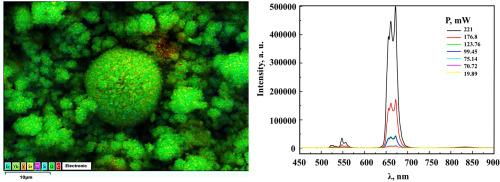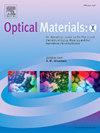含有 Er3+ 和 Yb3+ 离子的上转换微纳米磷的光致发光阈值现象
Q2 Engineering
引用次数: 0
摘要
在电子束蒸发绿色发光(λex = 980 nm)硅酸盐上转换(UC-PL)块状荧光粉 Sr2Y6.8YbEr0.2Si6O26 的过程中,形成了尺寸为 2.7 nm 的无定形纳米颗粒。这些纳米颗粒是由 SiO4 四面体组成的链在缩聚过程中形成的球状物。当用波长为 λex = 980 纳米的辐射激发球状颗粒时,发光颜色变为红色,其强度比块状荧光粉增加了 80 倍。研究表明,发光受 Er3+ 离子不同转变之间非辐射过程的影响。在泵浦功率相对较低的区域,Er3+ 和 Yb3+ 电平(2F5/2 电平)存在一个阈值。在该阈值之上,上转换光致发光的强度会急剧增加。我们的研究表明,所产生的纳米荧光粉具有一个由 SiO 四面体(n = 0、1、2)组合而成的核心,而 Er、Yb、Sr 和 Y 离子则位于球状荧光粉的表面。由于这种球状结构,Er 和 Yb 离子与核缺陷的相互作用减弱,而核缺陷通常会抑制发光。可能正是由于这个原因,发光强度才会增加。我们的研究结果表明,可以设计出新的有效非线性材料,用于将红外辐射转化为可见辐射。生产出的有效荧光粉有望成为生物研究、基础治疗以及新型显示技术中的荧光探针。本文章由计算机程序翻译,如有差异,请以英文原文为准。

Threshold phenomena in photoluminescence of upconversion micro- and nanophosphors containing Er3+ and Yb3+ ions
During electron beam evaporation of green-emitting (λex = 980 nm) silicate upconversion (UC-PL) bulk phosphors Sr2Y6.8YbEr0.2Si6O26, amorphous nanoparticles of size 2.7 nm are formed. The nanoparticles are globules formed during condensation of chains consisting of SiO4 tetrahedra. When the globules are excited with radiation of λex = 980 nm, the luminescence color becomes red and its intensity increases 80 times compared with bulk phosphors. It has been shown that luminescence is influenced by nonradiative processes between different transitions of Er3+ ions. There is a threshold population of the Er3+ and Yb3+ levels (level 2F5/2) in the region of relatively low pumping powers. Above this threshold, a sharp increase in the intensity of upconversion photoluminescence occurs. We show that the produced nanophosphors have a core consisting of a combination of SiO tetrahedra (n = 0, 1, 2), while Er, Yb, Sr, and Y ions are on the surface of the globules. Owing to this structure of the globules, the interaction of Er and Yb ions with nucleus defects, which usually suppress the luminescence, decreases. Probably, for this reason the luminescence intensity increases. Our findings reveal that new effective non-linear materials can be designed for converting IR radiation into visible radiation. The produced effective phosphors can hold promise as fluorescent probes in bioresearch, for fundamental therapy, as well as for new display technologies.
求助全文
通过发布文献求助,成功后即可免费获取论文全文。
去求助
来源期刊

Optical Materials: X
Engineering-Electrical and Electronic Engineering
CiteScore
3.30
自引率
0.00%
发文量
73
审稿时长
91 days
 求助内容:
求助内容: 应助结果提醒方式:
应助结果提醒方式:


